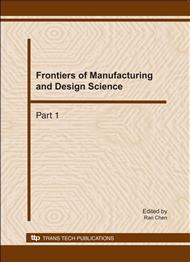p.2822
p.2827
p.2832
p.2837
p.2842
p.2847
p.2852
p.2857
p.2862
Research on the Properties of Milling and the Process Parameters Optimization for Aluminum-Alloy Thin-Walled Parts
Abstract:
In this paper, with the milling processing of aluminum-alloy thin-walled parts as the research object, using software AdvantEdge, a milling simulation model is developed to study milling parameters affect on the cutting force, heat and catenation. It is found that by adjusting the ratio of milling parameters, the effects of cutting forces and heat can turn to the favorable direction of workpiece. In addition, we combine numerical simulation with experiments to explore the law of optimization of process parameters. It is discovered that the method of improving the milling speed and reducing the cutting depth properly can ensure the milling efficiency and the quality of the workpiece, providing a scientific insight for achieving high-quality, low-cost and efficient thin-walled parts manufacturing.
Info:
Periodical:
Pages:
2842-2846
Citation:
Online since:
December 2010
Authors:
Keywords:
Price:
Сopyright:
© 2011 Trans Tech Publications Ltd. All Rights Reserved
Share:
Citation:


